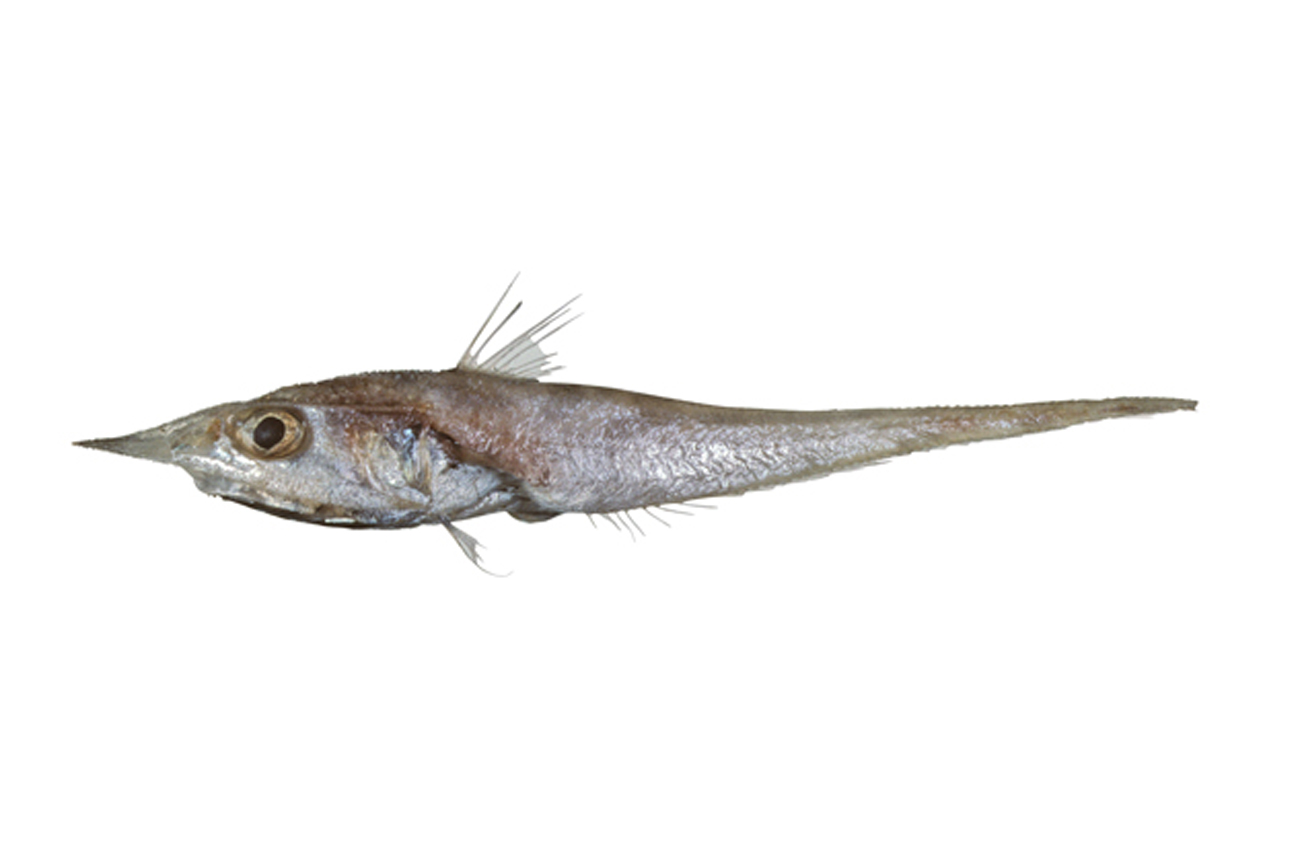Silver Whiptail, Coelorinchus argentatus Smith & Radcliffe 1912

Silver Whiptail, Coelorinchus argentatus. Source: Australian National Fish Collection, CSIRO. License: CC By Attribution-NonCommercial
Silver Whiptail, Coelorinchus argentatus Smith & Radcliffe 1912
More Info
|
Distribution |
North of Exmouth, Western Australia, to the Arafura Sea north of Melville Island, Northern Territory, and east of Murray (Mer) Island to east of Rockhampton, Queensland. Elsewhere the species occurs in the tropical, Indo-west Pacific (Philippines, New Caledonia). The species is benthopelagic on the continental shelf at depths of ~80-580 m. |
|
Features |
Dorsal fin II, 8-10; Pectoral fin 15-18; Pelvic fin 7; Gill rakers (inner) 8-9; Branchiostegal rays 6; Pyloric caecae about 9. Snout moderately long with slight humplike rise in dorsal profile over nostril, anterolateral margins not fully supported by bone; upper jaw about one-third head length, extending posteriorly below hind margin of orbit. Broad, median-ventral streak of a light organ extends from anus onto chest just behind isthmus. Body scales thin, with short, fine, conical spinules in slightly divergent rows to somewhat quincunx pattern. Scales on snout and interorbit thin, but densely covered with short, conical spinules. Underside of head completely naked (except for overlapping scales on snout), underside of snout with tiny black punctations and small, black, hairlike papillae; nasal fossa naked, naked area extending posteriorly onto suborbital shelf below anterior half of orbit. |
|
Size |
Reaches a total length of 37 cm. |
|
Colour |
Silvery over sides of head, ventral half of trunk and midlaterally on tail, chest dark, belly pale; a narrow tapering dark stripe extends from below origin of second dorsal to end of tail, stripe expanded anteriorly; blotchy or spotty markings present dorsally on nape and trunk; an elongate horizontal blotch present behind occipital region in most; side of abdomen peppered with with large dots becoming sparser ventrally. Second spinous ray of first dorsal fin blackish over distal three-quarters; anal fin darkish anteriorly, otherwise light dusky to clear; pelvic fin base dark and along outer ray, pale in middle; gill membrane with finely striated or reticulated pattern, upper jaw and lips densely pigmented, barbel dark to dusky. |
|
Feeding |
Carnivore - feeds on small crustaceans and polychaete worms. |
|
Biology |
Unknown. |
|
Fisheries |
The Silver Whiptail is occasionally caught by commercial trawlers working in relatively shallow waters, but is of no interest to commercial fisheries. |
|
Conservation |
|
|
Species Citation |
Coelorhynchus argentatus Smith & Radcliffe 1912, Proc.U.S. Natl. Mus. 43(1924): 137, pl. 31(1), off Jolo, Philippines, 6°03 'S, 120°35 'E. |
|
Author |
Bray, D.J. & Frankham, G. 2018 |
|
Resources |
Silver Whiptail, Coelorinchus argentatus Smith & Radcliffe 1912
References
Gloerfelt-Tarp, T. & Kailola, P.J. 1984. Trawled Fishes of Southern Indonesia and Northwest Australia. Jakarta : Dir. Gen. Fish. (Indonesia), German Tech. Coop., Aust. Dev. Ass. Bur. 406 pp.
Iwamoto, T. 1990. Family Macrouridae. pp. 90-318 in Cohen, D.M., Inada, T., Iwamoto, T. & Scialabba, N. FAO Species Catalogue. Gadiform fishes of the world (order Gadiformes). An annotated and illustrated catalogue of cods, hakes, grenadiers and other gadiform fishes known to date. FAO Fisheries Synopsis No. 125. Rome : FAO Vol. 10 442 pp.
Iwamoto, T. 1999. Families Macrouridae, Bathylagidae, Moridae, Bregmacerotidae. pp. 1986-1998 in Carpenter, K.E. & Niem, V.H. (eds). The Living Marine Resources of the Western Central Pacific. FAO Species Identification Guide for Fisheries Purposes. Rome : FAO Vol. 3 pp. 1397-2068.
Iwamoto, T. & Graham, K.J. 2008. Two new Australian grenadiers of the Coelorinchus fasciatus species group (Macrouridae: Gadiformes: Teleostei). Proceedings of the California Academy of Sciences 4 59(5): 133-146
Iwamoto, T. & Williams, A. 1999. Grenadiers (Pisces, Gadiformes) from the continental slope of western and northwestern Australia. Proceedings of the California Academy of Sciences 51(3): 105-243 figs 1-58
Merrett, N.R. & Iwamoto, T. 2000. Pisces Gadiformes: Grenadier fishes of the New Caledonian region, southwest Pacific Ocean. Taxonomy and distribution, with ecological notes. In: Crosnier, R. (ed). Résultats des Campagnes MUSORSTOM, 21. Memoires du Museum National d'Histoire Naturelle (N. S.) (Série A) Zoologie No. 184: 723-781.
Sazonov, Y.I. & Iwamoto, T. 1992. Grenadiers (Pisces, Gadiformes) of the Nazca and Sala y Gomez ridges, southeastern Pacific. Proceedings of the California Academy of Sciences 48(2): 27-95.
Smith, H.M. & Radcliffe, L. in Radcliffe, L. 1912. Descriptions of a new family, two new genera, and twenty-nine new species of anacanthine fishes from the Philippine Islands and contiguous waters. Proceedings of the United States National Museum 43(1924): 105-140 figs 1-11 pls 22-31



